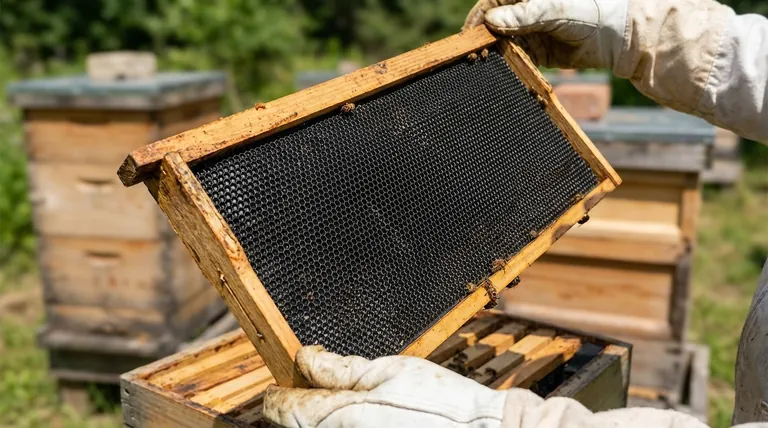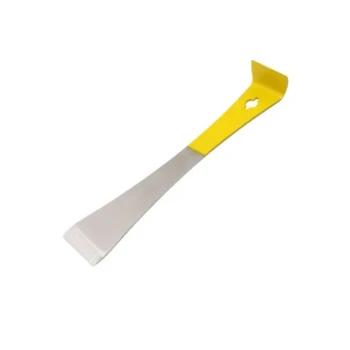The primary advantages of using wood frames with plastic foundation are their exceptional durability, ease of management, and alignment with industry standards. This combination leverages the strength and repairability of wood while benefiting from the resilience of plastic, which resists heat damage, breakage during honey extraction, and warping over time.
This hybrid approach offers a best-of-both-worlds solution for beekeepers. It combines the structural integrity and natural material of wooden frames with the longevity and operational efficiency of plastic foundation, creating a reliable system for both honey production and hive health.

The Benefits of the Wooden Frame
A frame's primary job is to provide structural support inside the hive. Wood has long been the traditional material for this, and for several good reasons.
Unmatched Durability and Repairability
Wooden frames are famously sturdy and rigid. This makes them easier to handle during hive inspections.
Unlike single-piece plastic frames, if a part of a wooden frame breaks, it can often be repaired or replaced, extending its service life.
Versatility and Natural Material
Wood is a natural and sustainable material, which is an important factor for many beekeepers. It poses no risk of chemical contamination to the honey or wax.
These frames are also versatile, as they can be fitted with either plastic or traditional wax foundation, giving the beekeeper more options.
Cost-Effectiveness
In most cases, wooden frames are significantly cheaper than fully plastic frames.
For those with basic woodworking skills, wooden frames can also be built from scratch, further reducing equipment costs.
The Power of Plastic Foundation
The foundation is the sheet inside the frame that gives bees a guide for building their comb. Plastic has become a preferred foundation material due to its modern advantages.
Superior Strength and Longevity
Plastic foundation is much stronger than traditional wax foundation. It will not melt in high temperatures, a common problem that can cause a total comb collapse in hot climates.
This strength also prevents it from breaking or blowing out during the high-speed centrifugal force of honey extraction. It maintains its shape for years and is highly resistant to pests like wax moths.
Simplified Hive Management
Plastic foundation is easy and fast to install in a wood frame, requiring no special embedding tools or wiring.
Because it is rigid, it helps ensure bees build straight combs, which prevents problematic cross-combing and makes hive inspections much smoother.
Enhanced Brood Inspection
Plastic foundation is available in different colors, most notably black.
Black foundation provides high contrast that makes it significantly easier to see tiny, white bee eggs, which is critical for assessing the health of the queen and the brood colony.
Understanding the Trade-offs
While the combination is highly effective, it's important to understand its context compared to other available options.
All-Plastic Frames
Fully plastic frames are delivered ready to use, requiring no assembly. They are also lightweight and their standardized, mass-produced dimensions ensure a perfect fit in hive boxes every time.
Natural Wax Foundation
The primary trade-off is the material itself. While highly efficient, plastic is not a natural substance in the hive. Beekeepers focused on "natural beekeeping" principles may prefer to use frames with a pure beeswax foundation.
Making the Right Choice for Your Hive
Selecting the right equipment depends entirely on your beekeeping goals. The wood frame and plastic foundation combination is a versatile workhorse that serves most needs well.
- If your primary focus is durability and efficient honey harvesting: This combination is ideal, as it stands up to heat and the stress of extraction, preserving the comb for bees to reuse.
- If your primary focus is easy hive inspections and colony management: This is an excellent choice, especially with black plastic foundation to simplify spotting eggs and assessing queen health.
- If your primary focus is minimizing costs: The combination of reusable plastic foundation and repairable, inexpensive wooden frames offers fantastic long-term value.
Ultimately, this system provides a pragmatic balance of strength, convenience, and reliability for the modern beekeeper.
Summary Table:
| Advantage | Wood Frame | Plastic Foundation |
|---|---|---|
| Durability | Sturdy, repairable | Resists heat, breakage, warping |
| Management | Easy handling | Promotes straight comb, easy egg inspection |
| Cost | Lower cost, repairable | Long-lasting, reusable |
Ready to upgrade your apiary with durable, efficient equipment? HONESTBEE supplies high-quality wood frames and plastic foundation to commercial apiaries and beekeeping equipment distributors. Our wholesale-focused operations ensure you get reliable, cost-effective supplies that enhance hive health and honey production. Contact HONESTBEE today to discuss your needs!
Visual Guide

Related Products
- Food Grade Plastic bee Foundation for Bee Frames
- Professional Drop-Style Hive Handles for Beekeeping
- Beehive Entrance Discs Plastic Bee Entrance Disc for Bee Hives
- Professional Galvanized Hive Strap with Secure Locking Buckle for Beekeeping
- HONESTBEE Classic Pry Bar Hive Tool with High Visibility Finish for Beekeeping
People Also Ask
- How to get bees to use plastic foundation? Master the Wax Coating and Resource Strategy
- Does plastic foundation affect honey quality or taste? A Practical Guide for Beekeepers
- How to get bees to draw out plastic foundation? Boost Comb Building with Proven Tactics
- How does plastic foundation differ from beeswax foundation? Choose the Best for Your Hive's Success
- Why is it beneficial to coat plastic foundation with beeswax? Boost Hive Acceptance & Comb Building



















